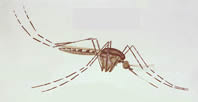American Gallinipper Mosquito - Fact Sheet
Meet Psorophora Ciliata
 Commonly known as the American Gallinipper or the Shaggy Legged Gallinipper, this mosquito. largest in the world, is impressive in size and aggressive in nature.
Commonly known as the American Gallinipper or the Shaggy Legged Gallinipper, this mosquito. largest in the world, is impressive in size and aggressive in nature.
At about 6 times the size of the common mosquito, Ps. Ciliata inflicts a powerful bite, said to feel like you are being stabbed! The voracious female of the species seeks blood meals day and night, becoming particularly aggressive if her habitat is invaded or disturbed. Due to its large size, the Gallinipper can even bite through clothing.
This pest can be identified by its unusual size (about the size of a quarter) and by the feathery dark scales on its hind legs.
What's in a name?
Even the name "Gallinipper" strikes a note of terrorl The word is thought to be derived from the word "Gally" - an English verb first seen in the 1600's meaning "to scare" or "to frighten" (probably itself a reference to the dreaded "gallows".) The word gallinipper became associated with various biting insects in the West Indies during the 1600's and 1700's. A Jamaican document from 1683 entitled Present State notes that "The most Offensive thing in this Island. Gallinippers, from their Biting." 1
This usage spread to the United States, especially the southern part of the country. The word gallinipper can be found in song lyrics and literature from the 1800's and was used by civil war soldiers as a blanket term for any biting insect 2. In 1823 a US navy ship named the Gallinipper (along with its sister vessel the Mosquito) launched a successful attack upon a a pirate schooner, led by Spanish pirate Diabolito. 3
Habitat and behavior
The American Gallinipper is not a common insect. It is considered to be a "flood mosquito" - one whose population surges after flooding from hurricanes and major storms. A document by Brunswick County NC Mosquito Control notes that it is "not uncommon to see large numbers of these mosquitoes in a post hurricane situation." 4
They are primarily found in the southeastern United States, but their range extends as far north as Ontario and Quebec, and well into the mid-west. Psorophora Ciliata has also been found as far south as Argentina.
Eggs are laid in the cracks of dry dirt in areas prone to collecting rain water. They remain dormant over the winter, usually hatching the following year after the first rainfall. Once hatched, the larvae feed voraciously, maturing into adults in a matter of about 6 days. The larvae are insatiable predators - dining upon the larvae of other mosquito species and even attacking tadpoles! It's tempting to think they could be used as part of a biological pest control program, but the unpleasant bite and predatory nature of the adults makes that unfeasible.
Health risks
Individual American Gallinippers have tested positive for west nile disease and various strains of encephalitis, However at the present time the CDC does not consider the species to be a vector in the transmission of any of these diseases 5. The gallinipper may be a formidable nuisance but at present it does not pose a major health hazard.
Control and prevention:
If a significant number of gallinipper mosquitoes have been found in your area, your government officials are probably on the case and will be spraying and taking other measures to reduce the population of these and other post-flood mosquito species.
For those out of range of these measures, standard mosquito control practices, like locating and eliminating sources of standing water, will help.
Due to their sheer size and robust physique, the Psorophora Ciliata may be less susceptible to standard insect repellents like picaridin or DEET. Still, the CDC advises the use of repellents in areas where they are a nuisance.
A study has shown that gallinippers are attracted by light - incandescent blue light, to be exact 6. Mosquito traps like the Dynatrap series, which uses light as one of their attractant methods, may be successful at controlling colonies on or near your property.
If biting insects of any kind are a nuisance, you may want to consider screening in your porch or gazebo. Low cost options such as the Mosquito Curtains system are versatile, effective and affordable and can be removed when not needed or for winter storage.
Further reading:
1Dictionary of Jamaican English (Ed. edited by Frederic Gomes Cassidy, R. B. Le Page)
2http://entomology.montana.edu/historybug/civilwar2/gallnippers.htm
3The history of our Navy from its origin to the present day, 1775-1897, John Randolph Spears
4http://www.brunswickcountync.gov/Portals/0/bcfiles/Mosquito_Control_Files/Psorophora_ciliata_Biology.pdf
5http://www.cdc.gov/ncidod/dvbid/westnile/mosquitospecies.htm
6Ali A, Nayar JK, Knight JW, Stanley BH. 1989. Attraction of Florida mosquitoes (Diptera: Culicidae) to artificial light in the field. Annual Conference of the California Mosquito and Vector Control Association 57: 82-88.
